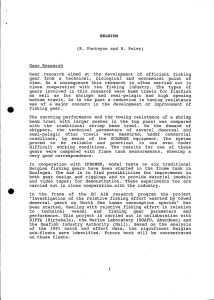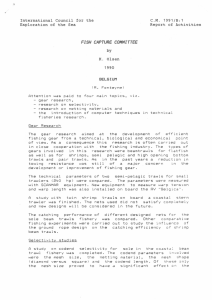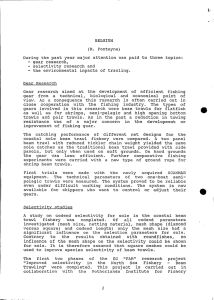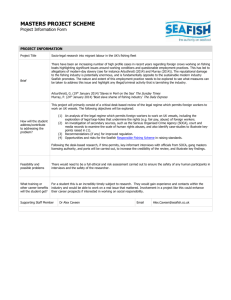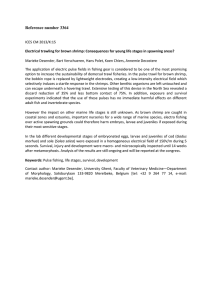BELGIUM
advertisement
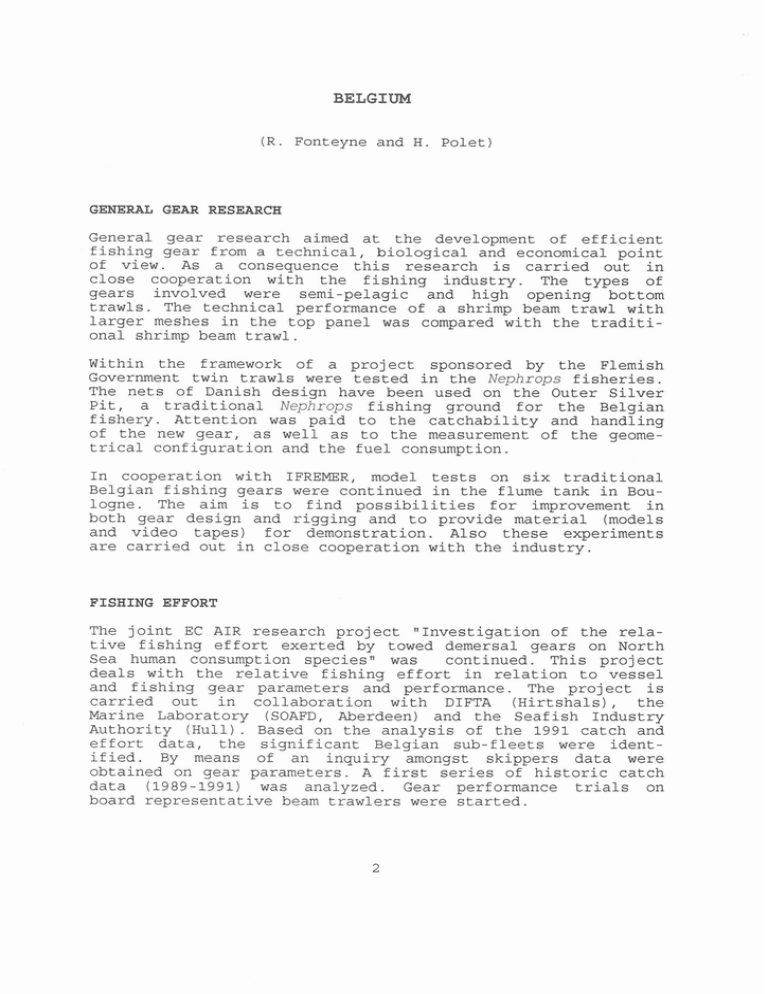
BELGIUM (R. Fonteyne and H. Polet) GENERAL GEAR RESEARCH General gear research aimed at the development of efficient fishing gear from a technical, biological and economical point of view. As a consequence this research is carried out in close cooperation with the fishing industry. The types of gears involved were semi-pelagic and high opening bottom trawls. The technical performance of a shrimp beam trawl with larger meshes in the top panel was compared with the traditional shrimp beam trawl. Within the framework of a project sponsored by the Flemish Government twin trawls were tested in the Nephrops fisheries. The nets of Danish design have been used on the Outer Silver Pit, a traditional Nephrops fishing ground for the Belgian fishery. Attention was paid to the catchability and handling of the new gear, as well as to the measurement of the geometrical configuration and the fuel consumption. In cooperation with IFREMER, model tests on six traditional Belgian fishing gears were continued in the flume tank in Boulogne. The aim is to find possibilities for improvement in both gear design and rigging and to provide material (models and video tapes) for demonstration. Also these experiments are carried out in close cooperation with the industry. FISHING EFFORT The joint EC AIR research project "Investigation of the relative fishing effort exerted by towed demersal gears on North Sea human consumption species" was continued. This project deals with the relative fishing effort in relation to vessel and fishing gear parameters and performance. The project is carried out in collaboration with DIFTA (Hirtshals), the Marine Laboratory (SOAFD, Aberdeen) and the Seafish Industry Authority (Hull). Based on the analysis of the 1991 catch and effort data, the significant Belgian sub-fleets were identified. By means of an inquiry amongst skippers data were obtained on gear parameters. A first series of historic catch data (1989-1991) was analyzed. Gear performance trials on board representative beam trawlers were started. SELECTIVITY STUDIES The development of a species selective beam trawl, with special emphasis on a substantial decrease of young roundfish discards while maintaining the level of flatfish catches, was the subject for the EC "FARN research project "Improved selectivity in the North Sea Fishery - Beam Trawling". This project has been carried out in collaboration with the Netherlands Institute for Fishery Investigations (RIVO, IJmuiden) and the Seafish Industry Authority (Hull). The selective devices consisted of a complete square mesh top panel, a large escape opening in the top panel just behind the beam, a square mesh window in the aft net and of combinations of these devices. Good results were obtained in releasing haddock and whiting, but for cod the results were not yet consistent. No meaningful losses in flatfish catches were noted. The study has been completed with a financial evaluation of the selective gears, showing only a marginal decrease in returns. A follow-on project "Optimisation of a species selective beam trawln has been started in the framework of the European AIRprogram. With again RIVO and Seafish as partners, the species selective beam trawls developed earlier will be optimized and tested on a larger range of vessels. There will also a closer collaboration with the fishing industry. So far model tests on improved designs have been carried out in the Seafish flume tank in Hull. A first series of experiments has been carried out on the influence of towing speed on the by-catch of roundfish and the codend selectivity of a 4 m beam trawl. Codend covers with hoops of different designs were tested but appeared not to be able to withstand the harsh conditions in beam trawling. An EC financed project on the selectivity of traditional Belgian Nephrops trawls and discarding practices in this fishery was finished. Together with the selectivity parameters of a 70 mm and a 80 mm codend the effects of the application of a square mesh window were investigated. The codend selectivity curves for Nephrops varied widely, with most of the variability attributable to the weather conditions. The 80 mm codend made of double yarn polyethylene netting proved to be less selective than the 70 mm polyamide single yarn codend. There was no strong evidence that Nephrops escape through the square mesh window but extra escapes for whiting included mainly marketable fish. Cooperation has been given to the FTFB-subgroup dealing with the design, performance and analysis of selectivity experiments. TECHNICAL/ECOLOGICAL ASPECTS OF TRAWLING The EC FAR project llEnvironmental impact of bottom gears on benthic fauna in relation to natural resources management and protection of the North Sea" was finished. This project was carried out in collaboration with institutes from the Netherlands, Germany and the UK. On the research vessel BELGICA the tracks of a 4 m beam trawl were studied by means of side scan sonar techniques and in s i t u inspection by divers. The pressure exerted by the sole plate of the beam trawl on the bottom was measured. For this purpose an instrumented beam trawl head has been developed. The pressure of the trawl heads on the sea bottom measured varied between 1.7 and 3.1 N/cm2, depending on the towing speed. Under normal commercial fishing conditions the maximum pressure of a 4 m beam trawl will be about 2 N/cm2. At the same time changes in the benthos population due to fishing operations as well as survival of the organisms caught were studied by the Dutch institute NIOO-CEMO.
